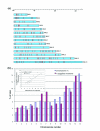piggyBac is an effective tool for functional analysis of the Plasmodium falciparum genome
- PMID: 19422698
- PMCID: PMC2686711
- DOI: 10.1186/1471-2180-9-83
piggyBac is an effective tool for functional analysis of the Plasmodium falciparum genome
Abstract
Background: Much of the Plasmodium falciparum genome encodes hypothetical proteins with limited homology to other organisms. A lack of robust tools for genetic manipulation of the parasite limits functional analysis of these hypothetical proteins and other aspects of the Plasmodium genome. Transposon mutagenesis has been used widely to identify gene functions in many organisms and would be extremely valuable for functional analysis of the Plasmodium genome.
Results: In this study, we investigated the lepidopteran transposon, piggyBac, as a molecular genetic tool for functional characterization of the Plasmodium falciparum genome. Through multiple transfections, we generated 177 unique P. falciparum mutant clones with mostly single piggyBac insertions in their genomes. Analysis of piggyBac insertion sites revealed random insertions into the P. falciparum genome, in regards to gene expression in parasite life cycle stages and functional categories. We further explored the possibility of forward genetic studies in P. falciparum with a phenotypic screen for attenuated growth, which identified several parasite genes and pathways critical for intra-erythrocytic development.
Conclusion: Our results clearly demonstrate that piggyBac is a novel, indispensable tool for forward functional genomics in P. falciparum that will help better understand parasite biology and accelerate drug and vaccine development.
Figures





References
Publication types
MeSH terms
Substances
Grants and funding
LinkOut - more resources
Full Text Sources
Other Literature Sources
Molecular Biology Databases

